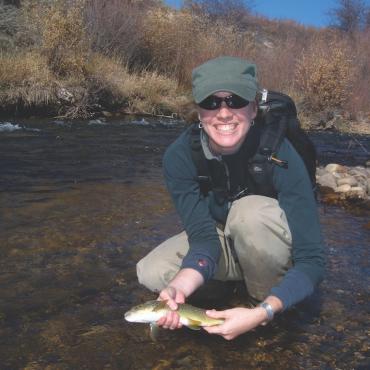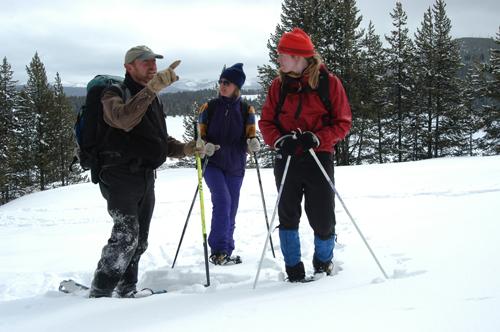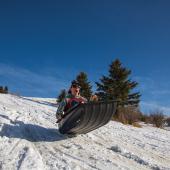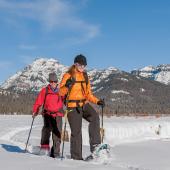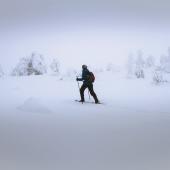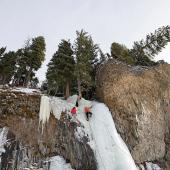A Quiet Ride Through Winter
Winter recreation in Yellowstone.
I had driven the stretch of Highway 191 between Four Corners and West Yellowstone countless times. I knew all of the best places to pass, and resisted the urge to hone my backseat driving skills on my guide and snowshoe companion for the day, Ken Sinay of Yellowstone Safari Company. Being a typical busy American, anxious and eager to pack the most action adventure into each and every day, I felt we were wasting precious time gazing about the electric lines for birds. Eagles, to be exact. As Ken craned his neck out the Suburban window in search of our white-hooded feathered friends, my foot pressed into the floor boards as I saw a perfect opportunity to pass a three-car caravan chugging along at a snail’s pace. I bit my tongue once again.
But Ken just kept looking toward the river, oblivious to the vehicular advantages slipping past. “Generally around the first weekend in March about 40 bald eagles pass through Gallatin County every day,” he said. “The best place to spy them is perched in the cottonwoods along the Gallatin River.” As Ken continued to explain the eagles’ behavioral and migratory patterns, I watched his demeanor change from mere curiosity to unbridled excitement. While Ken is just as much of an adrenaline junkie as the next Bozeman resident, he has a remarkably keen eye for the subtleties of nature and our outdoor world. His gaze toward the treetops grew more intent with each word. I realized that this was going to be an eye-opening day.
As we neared Lone Peak road, the turnoff for Big Sky and Moonlight Basin, Ken pointed out the rocky hillside just above the business center at the corner. “Bighorn sheep winter on that hillside, partly because people used to feed them.” We jumped out of the Suburban and grabbed a spotting scope from the back seat. Sure enough, there were four bighorn sheep munching away on the newly exposed grass, watching with little concern as cars and semi trucks roared by below. I couldn’t believe I’d never noticed them there before.
With a long and rich background of working and guiding in the greater Yellowstone area, Ken is a virtual walking (and jumping, running, smiling, and laughing) encyclopedia of the Yellowstone ecosystem. Sure enough, a little farther down the road Ken spied a coyote, rearing and pouncing on some burrowing critter underneath the snow’s surface. Using the binoculars we saw the lone predator stand incredibly still for minutes on end, and then suddenly pounce and bury his head beneath the surface, pulling out a chubby mouse for his mid-morning snack. He trotted away with his catch, back into the shadows of the forest as Ken pulled the Suburban back onto the highway and down the road toward the Fawn Creek trail head.
Fawn Creek is in the northwestern corner of Yellowstone National Park, on the edge of an enormous caldera that was once a belching, steaming volcano. As I pushed open the car door, the wind whipped spindrift across my cheeks and I tried to imagine this virtual winter wonderland covered in red, flowing lava. We had just received a fresh layer of snow the night before, making the trees and surrounding peaks look like something from a postcard, too perfect and stunning to be real.
We strapped on the snowshoes, which were incredibly lightweight and smaller than I’d imagined, grabbed our poles, and headed out across the highway toward a large hill on the west side of the road. Only minutes from the car, everything was quiet. No highway noise, no telephones, no televisions or radios—just an all-encompassing quiet that spread an involuntary smile across my face.
With some instruction from Ken, snowshoeing was surprisingly easy and I found myself bounding up the hillside, eager to crest the ridge to see what was on the other side. Ken stopped me abruptly and pointed to the ground immediately in front of me. There were tracks all over the snow, of all different shapes and sizes. Rabbit, fox, and ferret markings were fresh and clear in the new snow, again reminding me of nature outside the obvious. In such a quiet, still atmosphere it was hard to imagine an entire community of earth-dwelling critters so active in the winter months.
We reached the crest and gazed down into the valley below and at the gnarled peaks in the distance. “Now comes the really fun part: let’s slide!” Ken took off at a run down the steep, barren hillside into the valley leaving a spray of powder behind him. I took that as my cue and bounded downward, sliding on the back of my snowshoes, letting gravity take me on a most excellent roller coaster ride in the snow. After several laps, laughs, and falls, we stumbled back up to the crest. We dumped the snow out of our hoods and sleeves and enjoyed a cup of Earl Gray tea and cookies, soaking up the sun and gazing over into Bacon Rind, where I have spent many days carving up the powder but never once fully recognized the nature and wildlife that was all around me.
Eventually we slid our way back down toward the highway, this time with a little more restraint. “I always go fast on the way in,” Ken remarked, “but slow on the way back out.” I agreed; it gave me one last opportunity to contemplate the stillness before piling back into our two-ton hunk of civilization. A day in the hills is always enjoyable, no matter how you spend it: scaling a frozen waterfall, slicing through a perfect powder day, or enjoying a sunset soak in the Boiling River. But on this day, in particular, I dreaded leaving a place that I had discovered so intimately. It wasn’t about how many laps I skied or peaks I climbed, it was about all of the little wonders and experiences I enjoyed along the way. And once more, I found another reason to fall in love with my home all over again. After we stowed our gear and headed back up the canyon towards Bozeman, I thought about our tea time spent on the side of a mountain, and the words from an old Patti Griffin song, “Time will do the talking, years will do the walking, I’ll just find a comfy spot and wait it out.”

